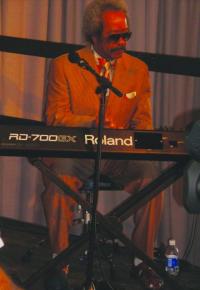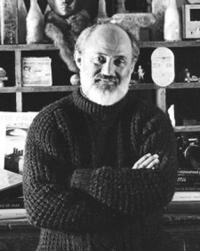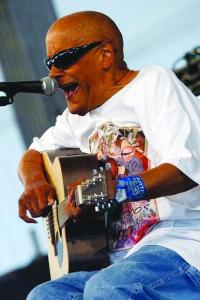
Allen Toussaint plays a tune while sharing memories about Snooks Eaglin.

Dr. John looking better than ever.

Michael P. Smith

Snooks Eaglin photo by Getty
I treasure my memories of seeing Snooks Eaglin perform on numerous occasions at d.b.a. on Frenchman Street. I’m so glad I bit the bullet and paid the cover to see this guitar legend because he left us this past February. Whether it was your first or one hundredth time seeing Snooks, you just had to shake your head and say “how’s he do it?”. Snooks had the most incredible hands and he was known as a human jukebox. He could play anything and never used a pick. He’d wrap his thumb around the top of the guitar neck to play bass lines while his fingers deftly provided rhythm and lead. His finger picking was just awesome. He’d switch from New Orleans style R & B to blues to classical “Malagueña” and was just, simply stated, a genius.
Snooks got this nickname by his family from the radio character “Baby Snooks” who was always getting into trouble. From what I’ve heard about Snooks, I’d suspect he’d be labeled hyperactive and AD/HD if he were in today’s school setting.
Allen Toussaint had many stories to share about Snooks. After Snooks had recorded the rhythm guitar on Sugar Boy Crawford’s ‘54 classic hit “Jock-a-Mo”, he formed a band with Alan and Ernie K-Doe called the Flamingos. Alan, then 14 years old, had a huge crush on Snooks’ sister, Beverly, and was often found just hanging out on the Eaglin’s front stoop. Snooks lost his sight as an infant when he had surgery for a brain tumor. Alan told a story about how the band would have allowed Blind Snooks to drive the car more often if he just didn’t drive so fast. Allen shared that Snooks met his wife Dee while in the Flamingos. Alan Toussaint said Snooks’ incredible fingers looked like they belonged on E. T.. Bass player George Porter played with Snooks and Professor Longhair a lot in the ‘70s and ‘80s and said Snooks was always playing the ‘heads up” game where he never called a tune but just jumped into it and you had to learn as you go as Snooks called chord changes to new songs.
Allen Toussaint talked about how it was Jazzfest producer Quint Davis who paired Snooks with legendary piano player Professor Longhair. Toussaint told how Davis took Eaglin and Longhair to record at Woodstock and there was a snow storm. Snooks said the sound of the falling snow kept him awake. Toussaint shared how Snooks often said “don’t play it pretty; play it raggedy”, and if the audience wasn’t clapping loud enough, Snooks would reply “this ain’t no funeral”. Allen Toussaint claimed that Snooks always loved an audience and he kept his boyish innocence quality.
Snooks was such a showman. He’d jump from here to there in his music and I’d take such pleasure being along for the ride. I can see him with a mischievous grin and hear him shouting out “Y’all hear that?”. Oh, how I would applaud.
Dr. John also had Snooks stories to share. Dr. John first played guitar and toured with Snooks and Jimmy Reid in the early years. John also said how he had no idea how Snooks played the way he did. Snooks spent many years playing at the Playboy Club in the French Quarter. Dr. John got him the gig and said his wife Dee never forgave John for this. John said “what did she think he could see?”. Dr. John was most upset that Snooks’ wake was at a bar and not a funeral parlor. He thought his favorite guitar player deserved more respect. By the way, I’ve never missed seeing Dr. John in all the years I’ve gone to Jazzfest. I’m delighted to report that Mac Rebbennack (his real name) looked better than I’d ever seen him. I’d venture to guess that he’d shed close to 100 pounds and still used a cane but walked so much better. I’ll write more about Dr. John, this year’s pick for Top Entertainer Big Easy Award, as we remember the fourth anniversary of Katrina at the end of August.
Dr. John lost another good friend that helped him get his start. Hayward “Chuck” Carbo passed away in July of last year. Carbo had an amazing and distinctive voice and was a major contributor to the classic era of New Orleans R & B. Like many vocalists, he started out in gospel music and then ventured into Rock & Roll. Cosimo Matassa, who headed the legendary New Orleans recording studio J & M thought that outside of Johnny Adams, Carbo had the finest voice in N’awlins. If you’re old enough or a collector, you may recall Carbo’s big hits in the ‘50s with the Spiders “I Didn’t Want to Do It”, “You’re the One” and “Witchcraft”. Perhaps Carbo’s best known hit in more recent times is the Mardi Gras favorite “Meet Me with Your Black Drawers On” recorded in 1989. In the ‘60s Carbo teamed up with Mac Rebbennack before Mac reincarnated himself as Dr. John. Mac said he so wanted Chuck to be on his Grammy winning post Katrina CD entitled The City That Care Forgot but his long time-friend was too ill with lung cancer.
I’d like to tell you about another Jazzfest treasure we lost this year and he is not a musician. I am speaking of Michael Smith who has captured the charm and spirit of the festival throughout the years since the fest began with his outstanding photos. Jazzfest producer Quint Davis said, “Mike was not only important in exposing traditional New Orleans culture to both New Orleans and to the entire world, but he was a great artist. He made great photographic images that also happened to be rare cultural treasures that enriched the rest of the world.”
Daughter Leslie Smith coauthored a History of Jazzfest several years ago. Everyone was talking about the book and the wonderful photos of her father and others in this book so I bought it while at Jazzfest that year. Several days later I met her in the French Quarter and she waited for me to run back to my hotel room to get the book so she could autograph it. We then walked to The Louisiana Music Factory to hear John Mooney perform.
Now, John Mooney is world renowned as one of the best slide guitarist and has played his Delta blues at most all Jazzfests. John talked to us after the show and told Leslie that her Dad was by far his favorite photographer as he always knew when to catch the action and get that special split second shot. By this time Michael Smith was quite ill (yet another to go downhill fast after Katrina) and I’m sure John’s words of praise were appreciated by Leslie and passed along to her Dad. When I got home from Jazzfest that year (‘07) I loaned the book for weeks at a time to friends who love New Orleans and Jazzfest. Leslie had so many great shots of musicians in that book, but my favorite photo by Michael Smith was of the long row of port-a-pots at Jazzfest with just huge lines in front of each as folks waited their turn. Upon more careful inspection, I saw there was a sole person on the other side of the port-a-pot row and couldn’t quite make out what he was doing but got quite a chuckle that Smith managed to get this humorous shot. Michael Smith has five books of his photos published and his full collection other than the photos at the Smithsonian and the Metropolitan Museum of Art are now housed at The Historic New Orleans Collection on Royal Street.
I was chatting with another famous photographer, Pat Jolly, who I met just after Katrina. Pat also works with the Musicians’ Clinic where I sent proceeds after several fund raisers I organized after Katrina. Pat told me to be sure and attend the parade at Jazzfest for Michael Smith and Snooks Eaglin. Now, the Funeral parade and second line are tradition in New Orleans. Pat Jolly said this would be a “back steppin” parade for Mike as that’s how photographers get their shots of parades by being in front and back stepping while shooting. The parade was something with folks carrying Smith photos and pictures of Snooks and Dee Eaglin. The parade ended at the Jazzfest Ancestors Area of the fairgrounds. This is where you find painted wooden life-size likenesses of those fest icons that have helped make Jazzfest what it is today. It is quite an honor to be included in this hall of fame in wood and paint, and the two additions of Smith and Eaglin were unveiled at the end of the second line parade. Some of the other “Ancestors” include Ed Bradley from “60 Minutes,” who just loved Jazz and was a huge fan of the Fest, Grammy winners Clarence “Gatemouth” Brown and Al Hirt, Jazz tubist and Preservation Hall founder Allan Jaffe and piano legend Professor Longhair.
Woops - I’ve written too much again and will save my remembrances of some of our great ladies like Marva Wright and Coco Taylor for next week. Ta for now.
«Go back to the previous page.



